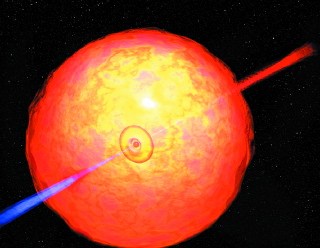In the 1960s, the United States secretly launched several satellites to check for illegal nuclear-weapons testing in space. Equipped with sensors able to detect the telltale x-rays and gamma rays that nuclear explosions emit, the satellites found no clandestine activities. Instead, they detected something remarkable. During their orbits, the satellites observed bursts of gamma raysflashes of extremely high energyappearing mysteriously from outer space.
 |
| A schematic illustration of a gamma-ray burst (GRB) in progress |
| Image courtesy of Caltech / Jonathan Williams |
Since then, scientists have tried unsuccessfully to explain the origins of such bursts, which can release in seconds the same amount of energy as 10 billion suns would emit over their entire lifetimes. Now, 35 years later, astronomers at the Harvard-Smithsonian Center for Astrophysics have presented the most compelling evidence yet that these bursts are released from supernovaemassive stars that have entered a state of collapse.
"This could be the smoking gun. We might be close to solving a long-standing mystery," says assistant professor of astronomy Krzysztof Stanek about the emerging connection between supernovae and gamma-ray bursts (GRBs). Along with astronomer Peter Garnavich of Notre Dame and others, Stanek has submitted a paper on these recent findings to the Astrophysical Journal.
Gamma rays are emissions of very high-energy electromagnetic radiation; a GRB releases this radiation in an intense, powerful jet. Yet GRBs, although they are the brightest objects in the universe, are not visible from earth. Gamma rays can exist undisturbed in the vacuum of outer space, but atoms and molecules absorb them when they reach the earth's atmosphere. Even outside the atmosphere, they are invisible to the human eye; just as our ears aren't sensitive to the high frequencies of a dog whistle, our eyes can't see gamma rays, no matter how bright they really are. To detect them, scientists must use telescopes and other instruments aboard satellites. However, a GRB's afterglowradiation that remains after the initial burstcontains radio waves and optical light: radiation we can detect from ground-based telescopes. Much of Stanek's data arises from observing changes in the optical afterglow.
Astronomers have long suspected supernovae to be progenitors of GRBs, but have been unable until now to gather convincing evidence. Because the bursts occur randomly and without warning, catching them is tricky. Stanek relies on other astronomers who are working with satellites (and doing research unrelated to gamma rays) to contact him the moment a new, very bright object appears in the sky. He carries a cell phone at all times. "Finding a GRB is often a matter of luck," he explains. "The positioning of the telescope is very important, since it can see only a small part of the sky."
The Italian-Dutch satellite Beppo-SAX detected the GRB that enabled Stanek's research on November 21, 2001. Just 10 hours later, he and his team began their ground-based observations of the burst's optical afterglow. The group needs to work quickly because the burst's spectacular light diminishes within hours. "GRBs are like Hollywood stars," Stanek notes. "They blow up really bright, and then they fade fast."
About 12 days after the burst, once the afterglow had dimmed, Stanek's team found an unexpected rebrightening in the same location. Since an afterglow declines steadily over time, this new light suggested a different but powerful energy source. It resembled the signature explosion of a supernova, caused by the collapse of a massive star no longer able to hold itself up against gravity. As the core of the dying star implodes into a black hole, it releases matter and energyincluding bursts of gamma raysat nearly the speed of light. If Stanek and his team had missed the afterglow, but happened to discover the new brightness, he says, "We would have thought it was just a supernova."
Although the star's collapse occurs around the same time as the GRB, the burst and its afterglow appear first. But because the gamma-ray jets are both brighter and faster than the supernova's explosion, their afterglow must fade before the supernova becomes visible. "The supernova was there from the beginning, most likely," says Stanek. "And it takes about two weeks for it to reach maximum brightness."
Besides helping to solve the mystery of GRBs' origins, Stanek's research provides a breathtaking peek at the origins of our own universe. The burst in question occurred in a galaxy more than six billion light-years awaya "cosmological distance," remote even by astronomical standards. When these gamma rays shot out from the collapsing core of a dying star, the earth had not yet been formed. The supernova that seemed to produce this GRB was possibly one of the very first stars, which were hugely massive and short-lived. Studying such distant bursts provides new information about our universe in its infancy and enables scientists to probe star formation. Stanek considers this data a useful tool for the next generation of gamma-ray satellites, which will react immediately to GRBs in distant space and offer a tantalizing glimpse at the early universe. "To see the first stars," says Stanek, "that is the Holy Grail of astronomy."
~Catherine Dupree
Krzysztof Stanek e-mail address: kstanek@cfa.harvard.edu





